Bright green pancakes filled with salty sweet pandan and coconut flavour are slathered in a rich golden coconut sauce. Let’s learn how to make Serabi Kuah at home!
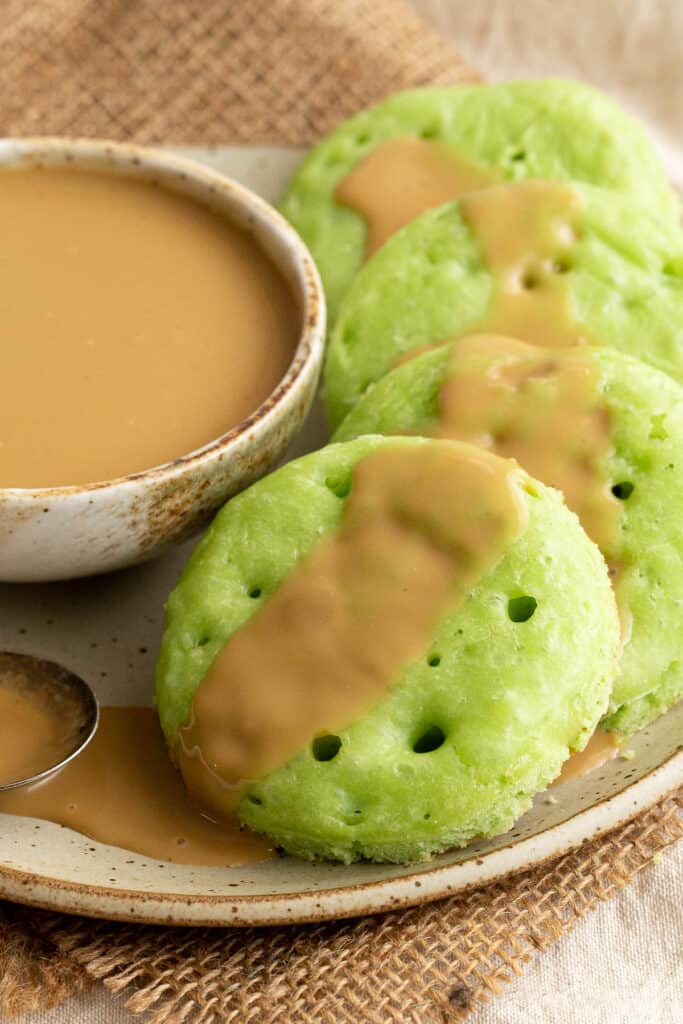
Why We Love This
We love eating serabi kuah for breakfast as a nice alternative to pancakes or crumpets.
The pancakes keep well too, so you can make a big batch for a crowd, or ensure that you have leftovers for dessert or breakfast the next day.
Related: Matcha Pancakes / Matcha Cookies
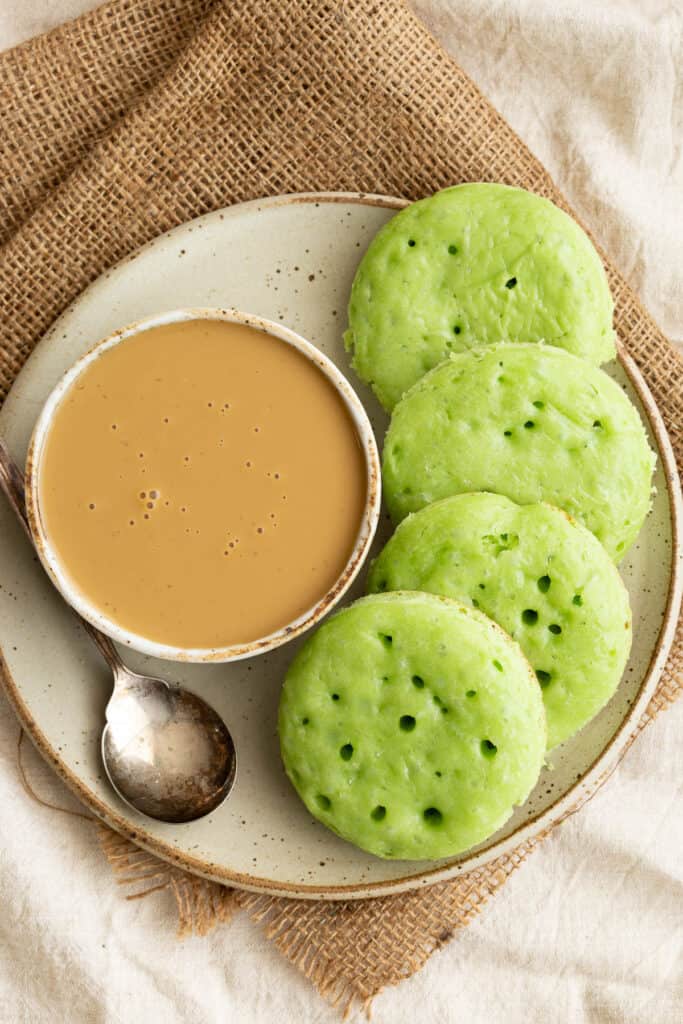
What is Serabi Kuah?
Serabi Kuah goes by many names including serabi kinca, kue serabi and srabi. These Indonesian pancakes will often be found at morning markets throughout Indonesia, or cooked up at street stalls for an afternoon snack.
The serabi, or pancakes, are usually made with a base of flour, rice flour and coconut milk. While the iconic green with pandan extract is a popular choice, you can also get white plain coconut based serabi as well.
The sauce is known as kuah or kinca (pronounced kwah and kincha) and is made with coconut milk and palm sugar.
Where We First Discovered Them:
We first ate serabi from the local morning market in Legian, Bali. It was a five minute walk from our homestay, and every morning we’d head there to try a new dish or handful of sweet treats. The serabi were usually around 1000 rp / $0.10AU each. We’d happily eat them for breakfast, sometimes alongside klepon, dadar gulung and nasi goreng or mie goreng.
What You’ll Need
- Flours – You’ll need plain / all purpose flour and rice flour. Look for regular rice flour in the clear bag with red writing, not glutinous, for the best results. Substitute the rice flour with tapioca flour, cornstarch or just more plain flour.
- Coconut Milk – This adds coconut flavouring to both the pancakes and sauce. For an extra decadent result, use coconut cream instead.
- Baking Powder – This helps to give you light and fluffy pancakes alongside the yeast. Sub with cream of tartar, lemon juice or vinegar.
- Instant Yeast – Instant yeast is simple to work with – just pop it in the mix and let time work it’s magic. The warm milk is what helps to activate the yeast quicker.
- Palm Sugar – Known as gula melaka, this is a dark brown sugar with a uniquely rich, almost smoky caramelised flavour. Sub with brown sugar, molasses or coconut sugar.
- Pandan Flavouring – You can use fresh pandan extract, pandan juice or artificial flavouring. Look for ‘pasta pandan’ (aka pandan paste) at your Asian grocer or buy it online. Sub with vanilla essence.
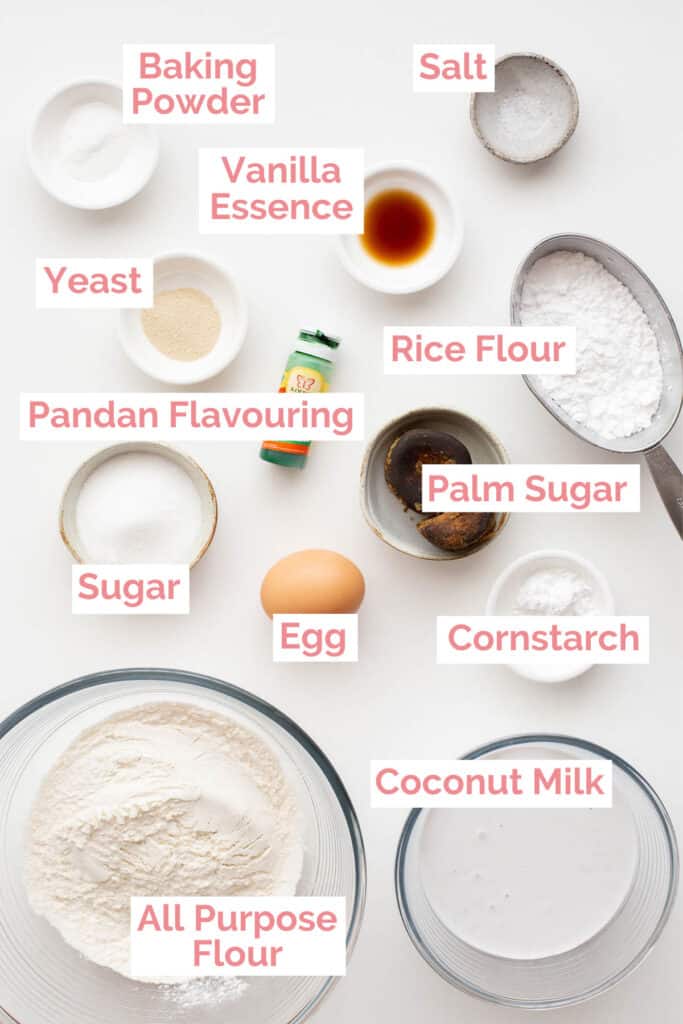
How to make Coconut Pandan Pancakes:
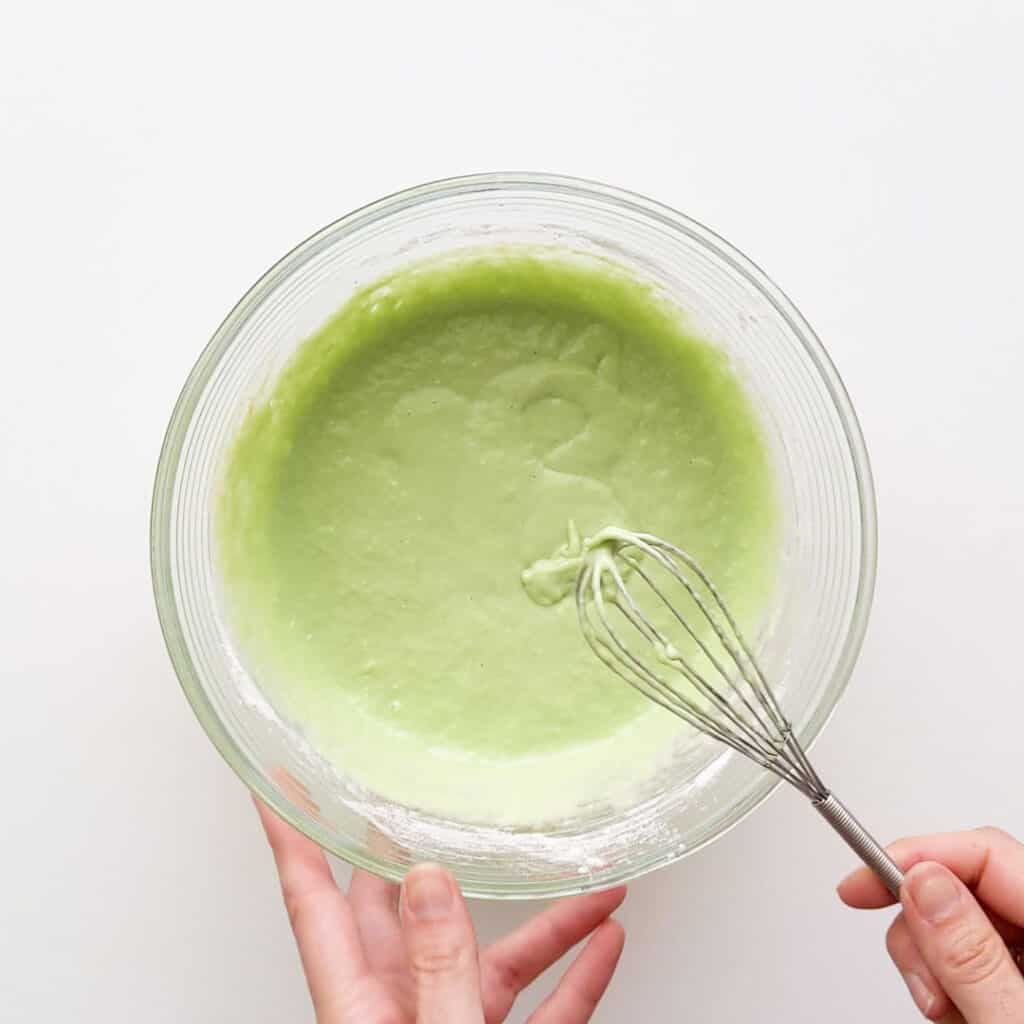
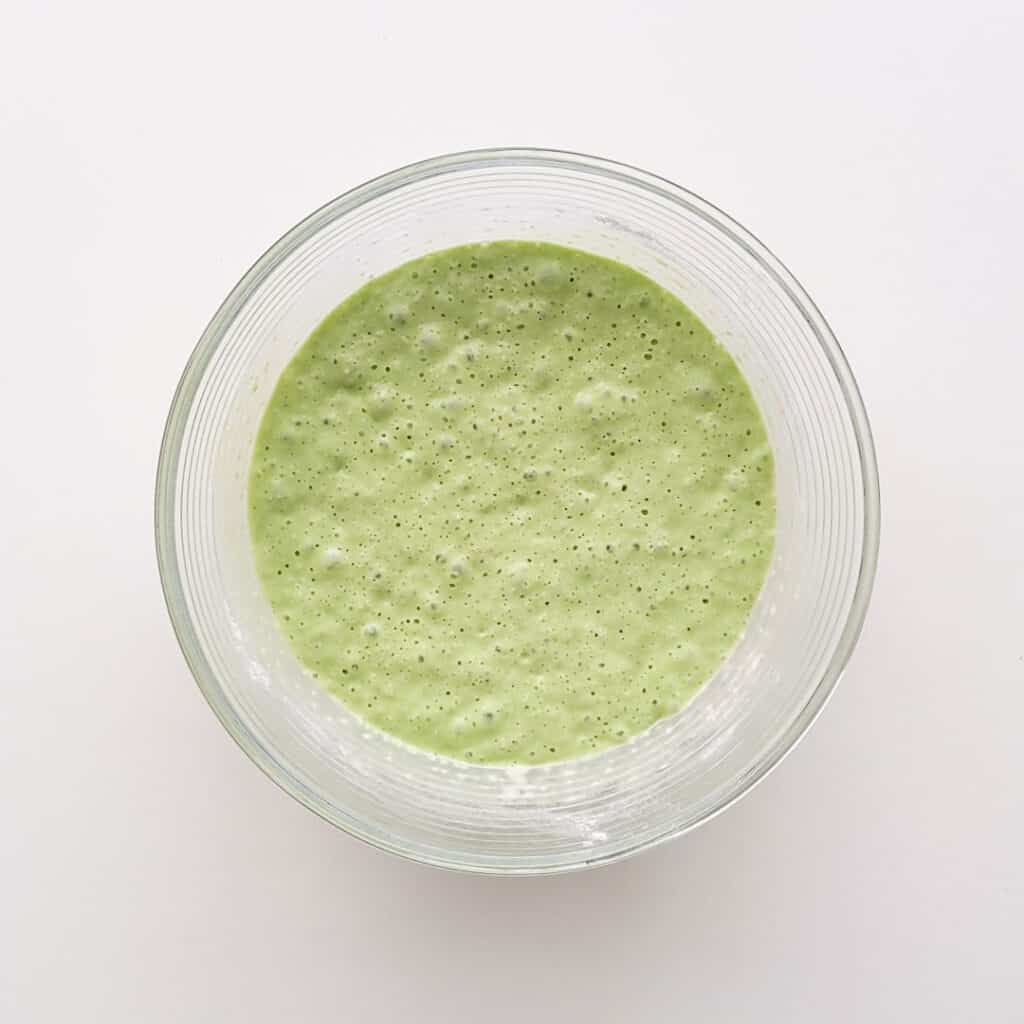
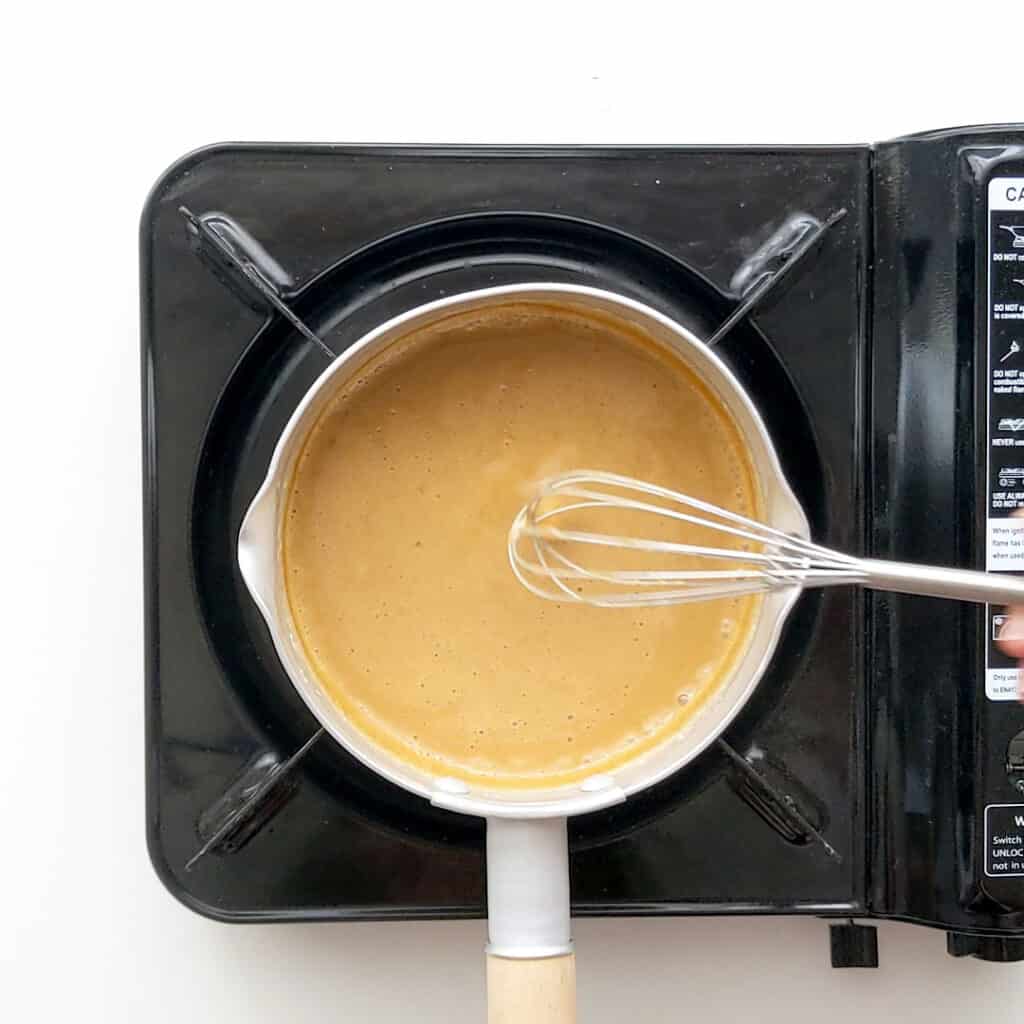
- For the pancake batter: Place the all purpose flour, rice flour, caster sugar, instant yeast and baking powder in a medium mixing bowl. Give it a quick mix, then add the salt (this is to separate the yeast from the salt, which can kill it).
- Make sure your coconut milk is warmed (45 seconds in the microwave should do it!) and pour this into the dry mixture slowly, whisking as you go. Once combined, crack in your egg, and whisk again. Next, add your pandan flavouring and stir through one last time.
- Cover bowl with a silicone lid or cling wrap and store in a warm place for at least an hour or two, or until the mixture doubles and is full of bubbles.
- For the coconut and palm sugar sauce (kuah / kinca): In a small saucepan, pour in your coconut milk and cornstarch. Whisk together until combined then turn your heat to medium-low. Next add in the chopped palm sugar, vanilla essence, and salt.
- Continue stirring until all the sugar has dissolved and the sauce turns a nice golden brown. Note: Watch your heat here and be careful not to boil the coconut milk.
- Switch off the heat and allow the sauce to cool while the pancake batter rises. If it starts to form a skin on top as it cools, just whisk to combine.
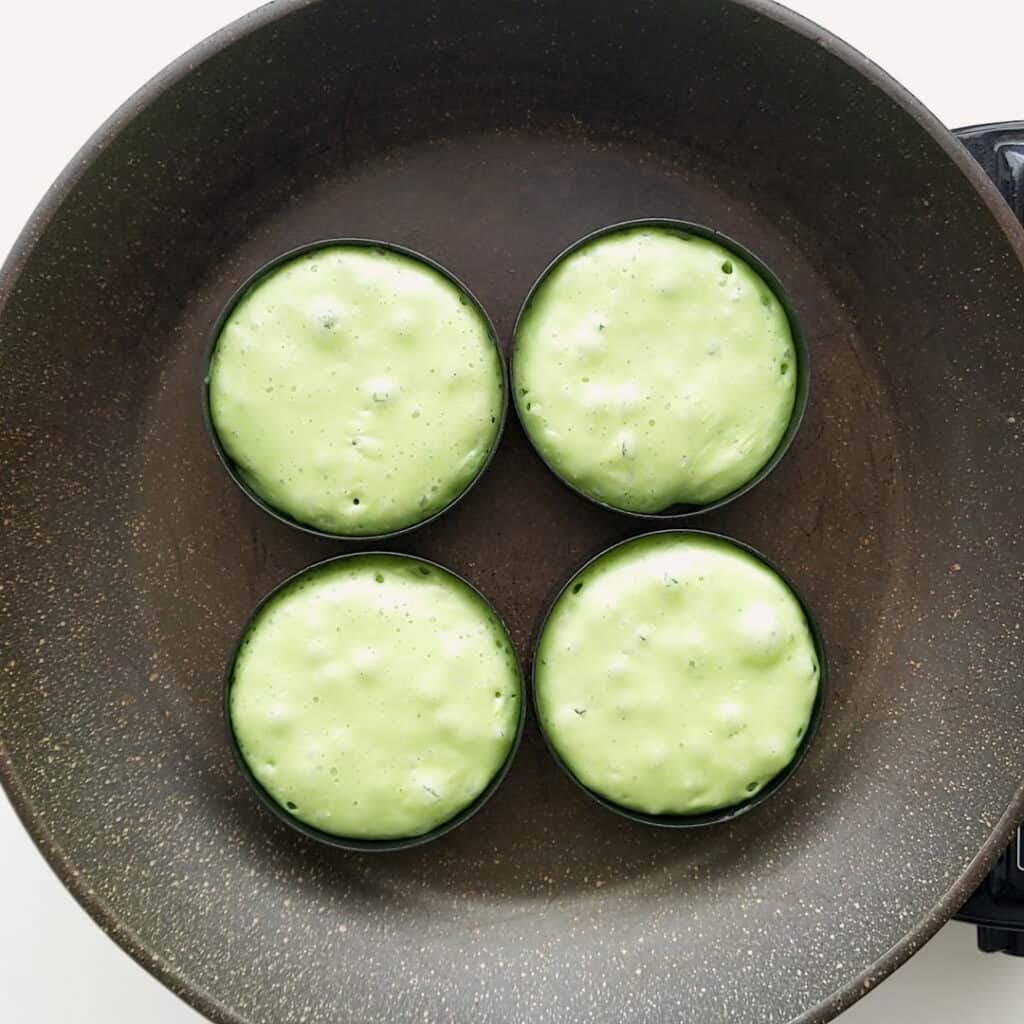
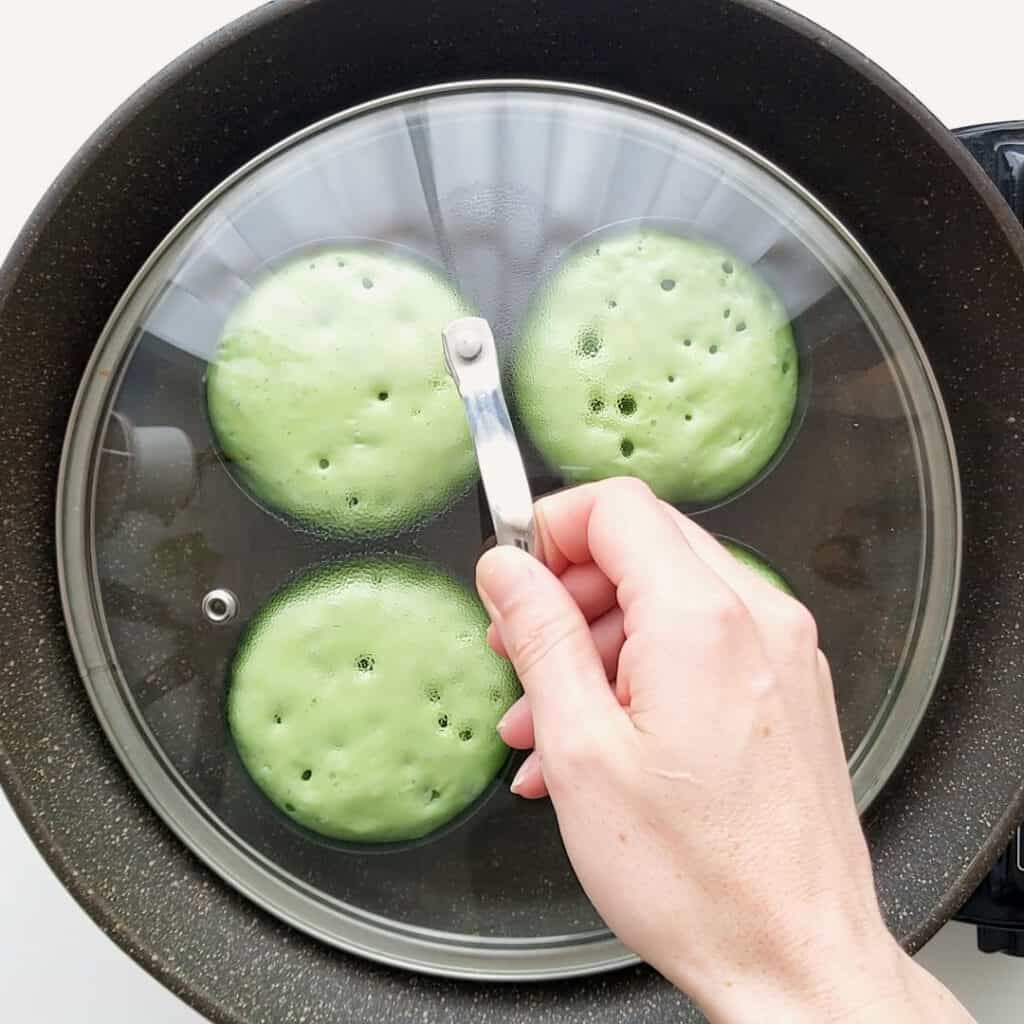
- To cook the pancakes: Using a non-stick frying pan over low-medium heat, ladle in enough batter to make 3-4 serabi per batch, around 7 cm / 3 inches in diameter. You can use greased egg rings for a more uniform shape. Using low heat and no oil or butter on the pan will give you a nice and crispy, light brown base with each pancake.
- Once most bubbles have popped on top of the pancakes, cover with a lid and allow the tops to cook and steam for a minute or two.
- Repeat the above until all the serabi are cooked. Serve immediately with the coconut and palm sugar sauce.
Wandercook’s Tips
- For the Perfect Rise – If you’re in a cool climate, turn your oven on to it’s lowest setting for a few minutes, then switch it off. Place the bowl (glass or metal only) in the oven and on a cork or cloth mat, so you don’t overheat the bottom. This will speed up the rising process by at least double!
- Keep It Sustainable – Instead of using single use cling wrap on your bowl, pop on a reusable silicone lid. These are great at retaining moisture and heat in the bowl, and one of our favourite eco-tips for the kitchen.
- Watch the Edges – Make sure to leave some room at the edges of your pan to make sure the lid can fit over the top of every pancake without squishing any of them!
- Pick the Best Palm Sugar – When picking what palm sugar to use – look for dark colours, and names like gula melaka or gula merah. The sugar should be soft and easy to cut. A lot of cheaper palm sugars are light in colour and filled with regular sugar, which can make them hard and difficult to cut.
- Low Heat – Make sure to cook the pancakes and sauce on a low heat for the best results! It may take longer, but they’ll be cooked through and won’t burn.
FAQs
Yes, you can make the pancakes with any milk. Add some dessicated coconut or coconut flavouring as well to enhance it.
For the sauce, it’s best to use coconut milk or coconut cream as this is the main ingredient of the dish!
While you can eat serabi by themselves or slathered in the kuah / kinca sauce, there are many toppings you can pop on them too. Favourites include:
– Chocolate sprinkles and banana, like in hagelslag.
– Kaya jam
– Condensed milk, similar to having Vietnamese pandan waffles
– Regular chocolate or caramel sauce
– Fresh fruit – which you can also dip into the coconut and palm sugar sauce to make it go even further
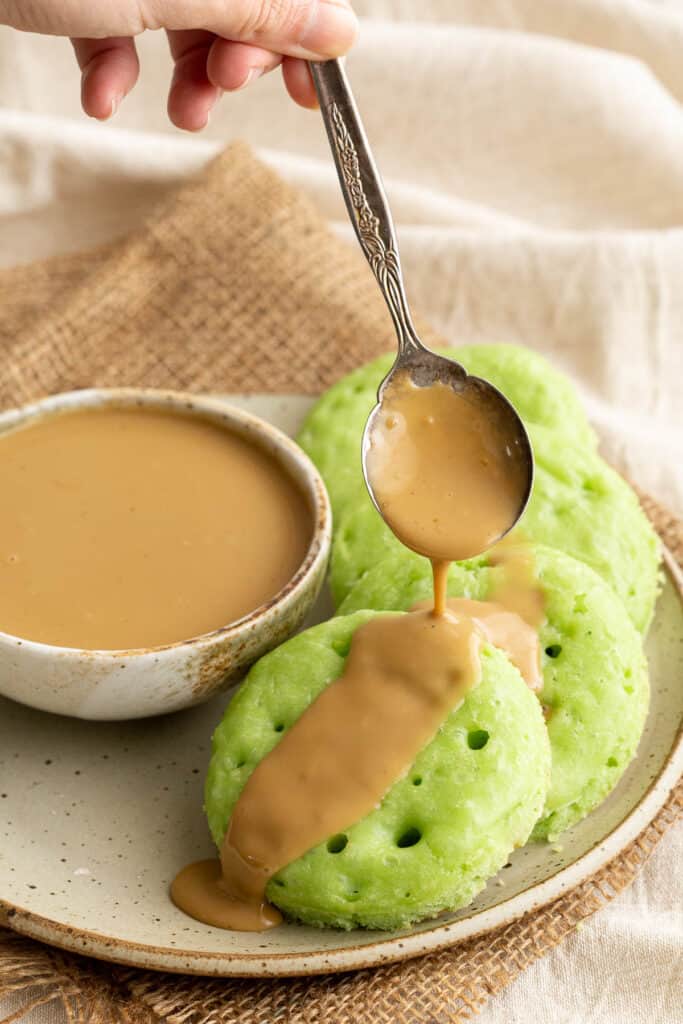
Love pandan desserts? Try these Asian sweets next:
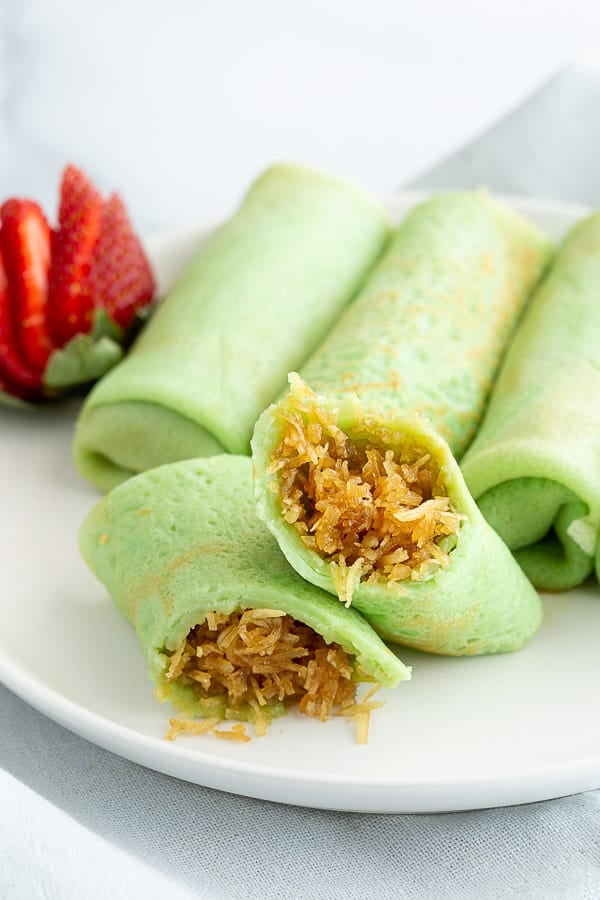
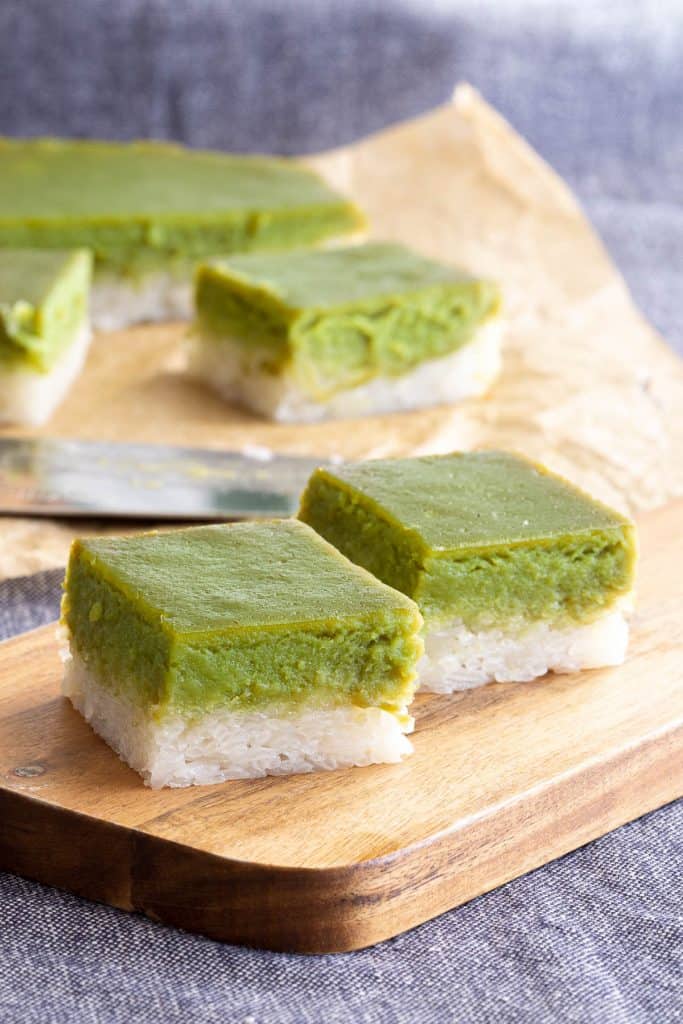
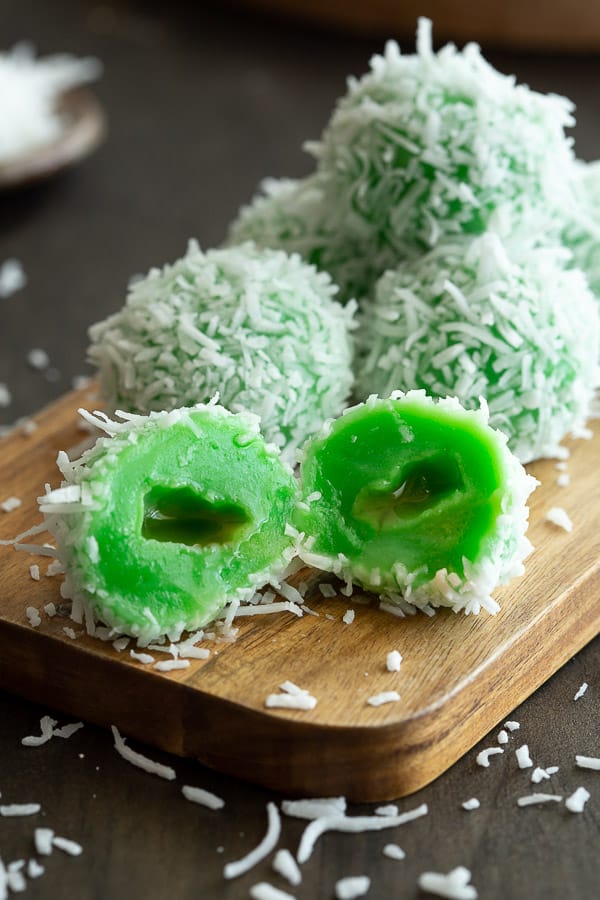
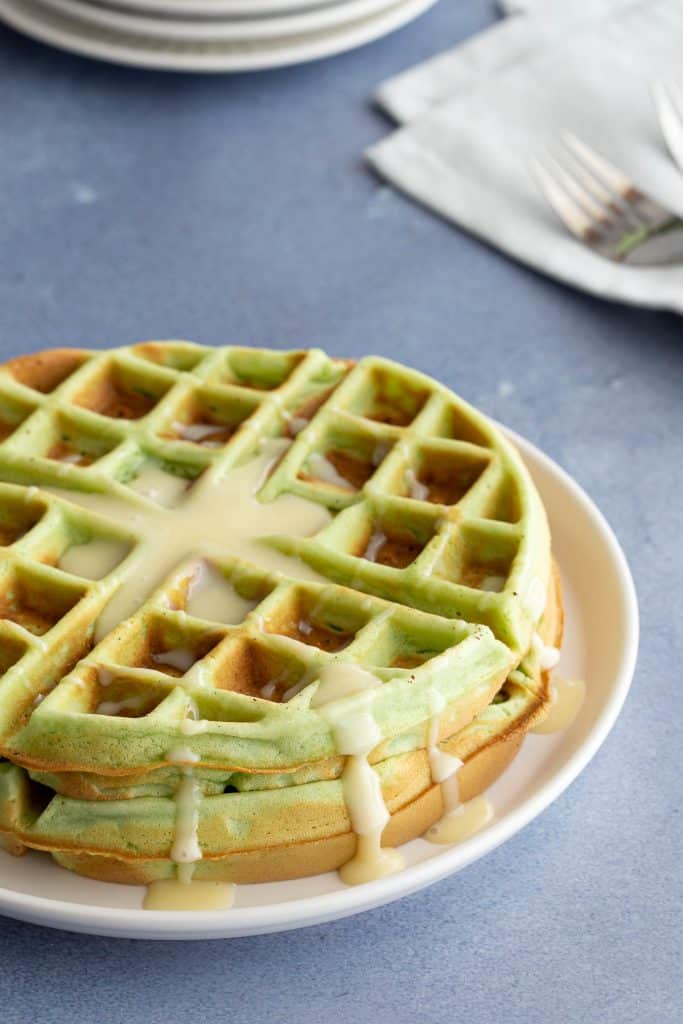
★ Did you make this recipe? Please leave a comment and a star rating below!
Equipment
Ingredients
For the serabi pancakes:
- 1 cup plain flour / all purpose flour slightly heaped, 150g / 5.3oz
- ½ cup rice flour 50g / 1.7oz, sub tapioca flour or cornstarch
- 2 tbsp caster sugar / superfine sugar
- 1 egg
- 1 cup coconut milk luke warm
- 1 tsp dried yeast 5g / 0.17oz
- 1 tsp baking powder
- 1/2 tsp salt
- 1/2 tsp pandan flavouring sub with fresh pandan extract or 1 tbsp pandan juice
For the coconut sauce (kuah / kinca):
- 1 cup coconut milk
- 80 g palm sugar 2.8oz, chopped small
- 1 tsp vanilla essence sub with fresh pandan extract or 1 tbsp pandan juice (will affect colour)
- 1 tsp cornstarch
- 1/2 tsp salt
Instructions
For the pancake batter:
- Place the all purpose flour, rice flour, caster sugar, instant yeast and baking powder in a medium mixing bowl. Give it a quick mix, then add the salt (this is to separate the yeast from the salt, which can kill it).1 cup plain flour / all purpose flour, ½ cup rice flour, 2 tbsp caster sugar / superfine sugar, 1 tsp dried yeast, 1 tsp baking powder, 1/2 tsp salt
- Make sure your coconut milk is warmed (45 seconds in the microwave should do it!) and pour this into the dry mixture slowly, whisking as you go. Once combined, crack in your egg, and whisk again. Next, add your pandan flavouring and stir through one last time.1 egg, 1 cup coconut milk, 1/2 tsp pandan flavouring
- Cover bowl with a silicone lid or cling wrap and store in a warm place for at least an hour, or until the mixture doubles.
For the coconut and palm sugar sauce (kuah / kinca):
- In a small saucepan, pour in your coconut milk and cornstarch. Whisk together until combined then turn your heat to medium-low. Next add in the chopped palm sugar, vanilla essence, and salt.1 cup coconut milk, 80 g palm sugar, 1 tsp vanilla essence, 1 tsp cornstarch, 1/2 tsp salt
- Continue stirring until all the sugar has dissolved and the sauce turns a nice golden brown. Note: Watch your heat here and be careful not to boil the coconut milk.
- Switch off the heat and allow the sauce to cool while the pancake batter rises. If it starts to form a skin on top as it cools, just whisk to combine.
To cook the pancakes:
- Using a non-stick frying pan over low-medium heat, ladle in enough batter to make 3-4 serabi per batch, around 7 cm / 3 inches in diameter. You can use greased egg rings for a more uniform shape. Using low heat and no oil or butter on the pan will give you a nice and crispy, light brown base with each pancake.
- Once most bubbles have popped on top of the pancakes, cover with a lid and allow the tops to cook and steam for a minute or two.
- Repeat the above until all the serabi are cooked. Serve immediately with the coconut and palm sugar sauce.
Video
Recipe Notes
- For the Perfect Rise – If you’re in a cool climate, turn your oven on to it’s lowest setting for a few minutes, then switch it off. Place the bowl (glass or metal only) in the oven and on a cork or cloth mat, so you don’t overheat the bottom. This will speed up the rising process by at least double!
- Keep It Sustainable – Instead of using single use cling wrap on your bowl, pop on a reusable silicone lid. These are great at retaining moisture and heat in the bowl.
- Watch the Edges – Make sure to leave some room at the edges of your pan to make sure the lid can fit over the tops of every pancake without squishing any of them!
- Pick the Best Palm Sugar – When picking what palm sugar – look for dark colours, and names like gula melaka or gula merah. The sugar should be soft and easy to cut. A lot of cheaper palm sugars are light in colour and filled with regular sugar, which can make them hard and difficult to cut.
- Low Heat – Make sure to cook the pancakes and sauce on a low heat for the best results! It may take longer, but they’ll be cooked through and won’t burn.
Nutrition
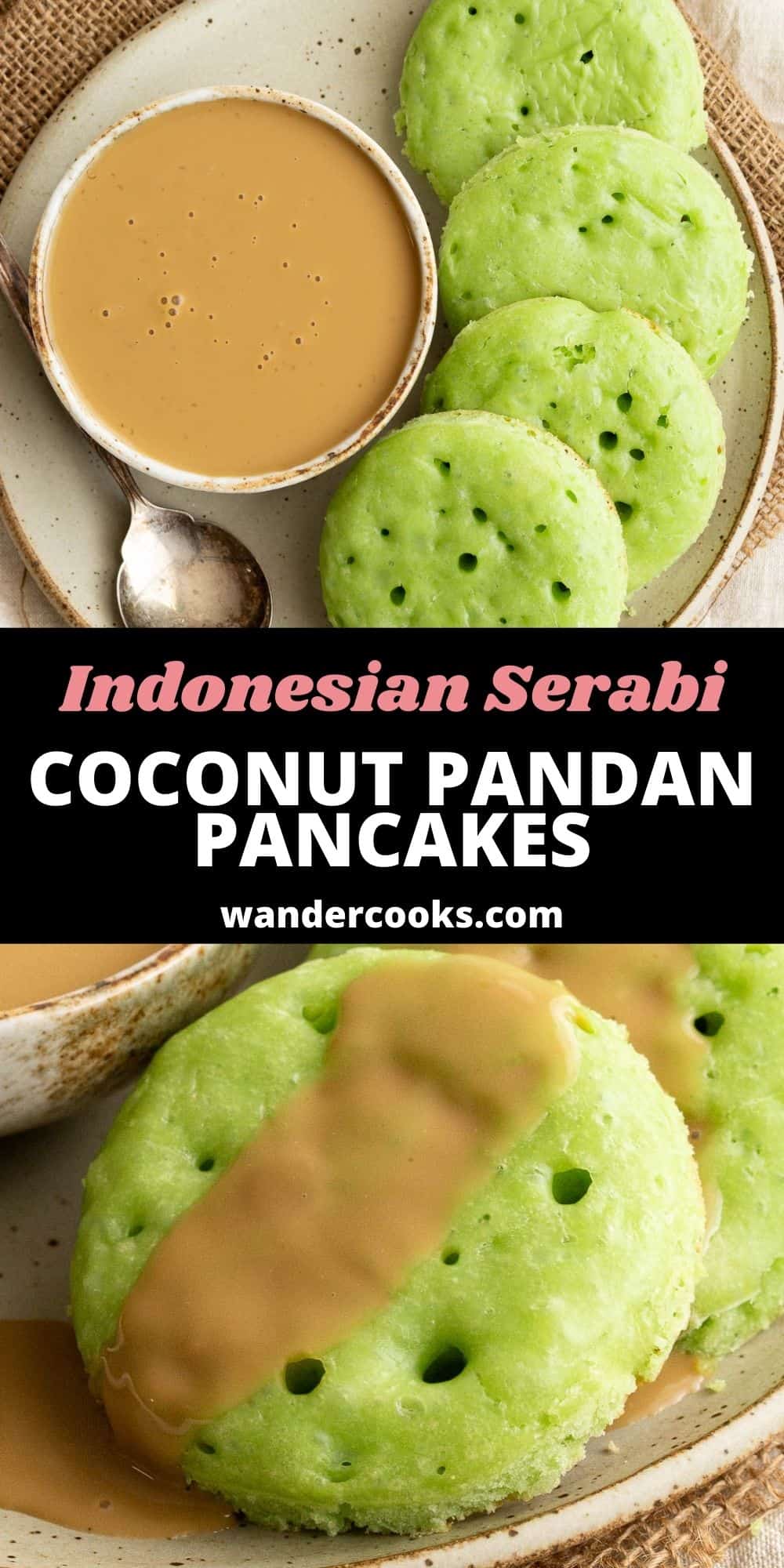

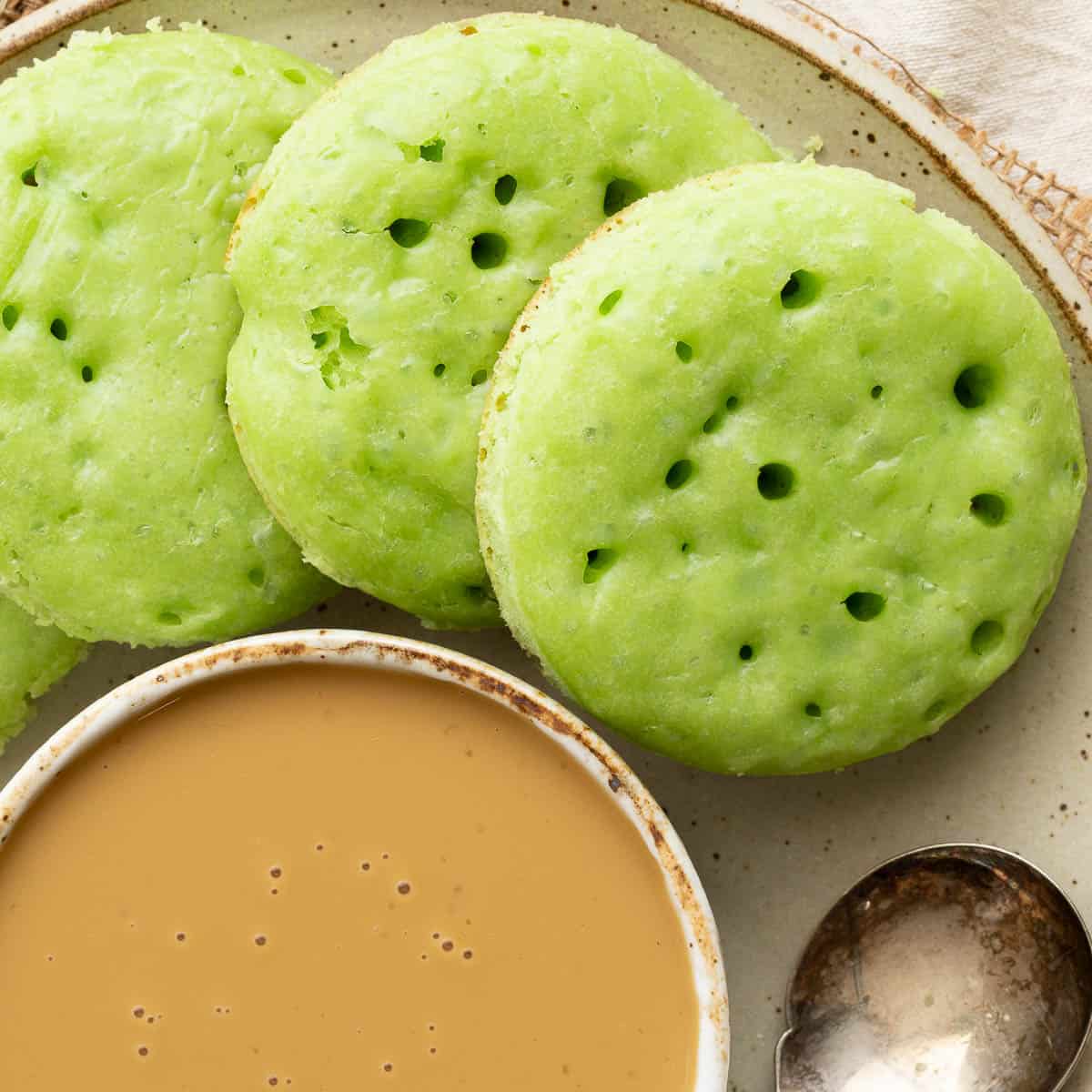



No Comments